It’s easy to focus on the major needs when talking about survival. Food, water, fire and a few other things get a lot of airtime, when it comes to discussing what we need. But the reality is, there are a lot of minor things that are necessary as well. Having enough clean water to drink and food to eat won’t matter for much, if you and I end up dying of disease.
That’s why we need soap. Yes, something as simple as soap is actually important to our survival. It’s one of the biggest and best defenses we have against disease. Soap not only helps us to clean dirt and germs off of our hands, but it is a fairly good antibacterial as well.
But what do you do when there’s no soap to be found? One option is to use the root of the yucca plant.
Yucca grows throughout the Midwest and Southwest, from Texas up to Alberta, Canada, although it is found mostly in warmer climates. This amazing plant is useful for a lot of things, with the roots being edible. The root of the plant is a tuber, like a potato; with the liquid pressed out of it is also usable as soap and shampoo.
Digging Up the Yucca
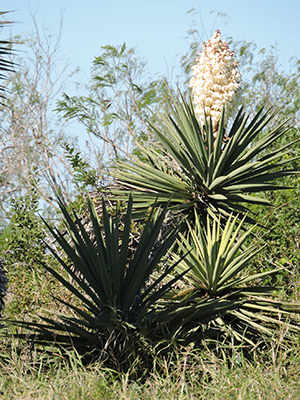
Yucca are fairly easy to dig up, as the tuber is the only real root of any size. The rest of the roots are hair size and break easily. But the tuber itself can go quite deep, especially on a large plant like the one shown above. If you’re going to dig up a yucca, I’d recommend using a smaller plant, like the one I’m digging up below.
Before going any farther, I need to mention that it is not legal to dig up yucca in all places. I was able to dig this plant up, because it was on private property and the owner wanted to get rid of it.
The plant shown in this photo was found in the wild and would have been illegal for me to harvest. So before you do this, make sure you’re doing it someplace where it is legal; unless, of course, you’re in a survival situation.
As I’m doing this for survival purposes, I decided to try digging it up with a machete, rather than a shovel, under the assumption that I might not have a full-sized shovel available to me.
I wouldn’t want to try and dig up a yucca with the small folding shovel I have in my bug out bag, because the ends of the leaves are all thorns. Digging it up with that small a shovel would probably see my hands scratched up pretty badly.
Related: This Super Root Preserves Meat Indefinitely!
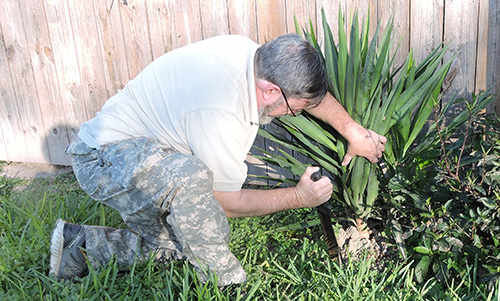
As you can see in the photo, I’m holding the leaves aside, while I dig with my machete. What I did was insert my arm under the leaves, and then lift it up, pushing the stiff leaves up with my arm. I was then able to turn my hand around and grasp them, getting them out of my way.
Once the leaves are out of the way, it’s a simple matter to stab the machete into the ground, all around the root. I made a circle about eight inches in diameter, which was enough. Then, grasping the plant’s stalk, near the root, I simply wiggled it back and forth, breaking the root free and was able to lift the plant out of the ground.
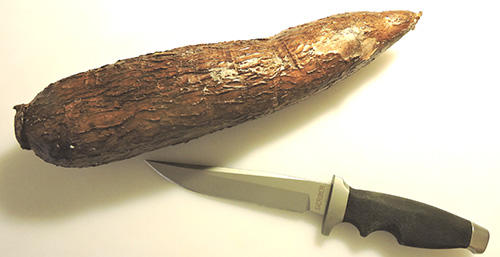
The leaves of the yucca can be used for other things, like making some pretty good sandals; but for now, all we need is the root, so I cut it off at ground level, with one swipe of my machete. Once cleaned, the root looks like this.
Cutting Up the Root
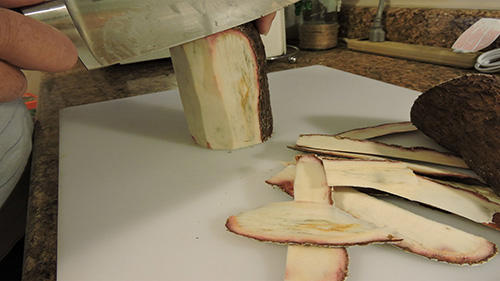
As you can see in the picture above, the root is covered by a thick skin or husk. We’re going to need to cut that off, much like cutting the outside off of a pineapple. It is hard, but not all that difficult to cut. In order to make it easier, I cut the root in half, allowing me to put the flat, cut end on my cutting board. The skin of the root cuts off fairly easy, if you have a good, sharp knife. I had no problem, but I’m using a very high quality knife with a really sharp edge. Notice the red around the edges of the pieces in the foreground. This all needs to be cut off, as well as the dark lines you can see in the piece I’m cutting.
Related: 10 Edible Roots That Kept This Hermit Monk Alive
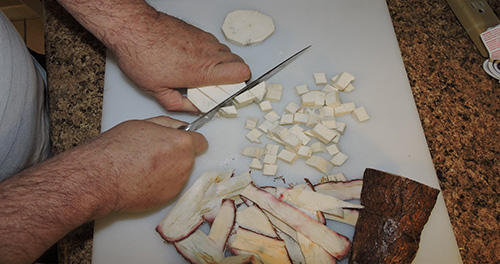
The peeled root is then sliced and diced. I did about ½” cubes. You can do smaller, but I wouldn’t recommend any larger. The ½” cubes worked well for my needs.These cubes of yucca root then need to be broken down. Even though I’m working in my kitchen at this point, I didn’t use a food processor or blender for this. We’re doing this for survival soap and I doubt that any of us keep a food processor in our bug out bags or survival kits. We need something that’s more on the order of what we’d use in such a situation.
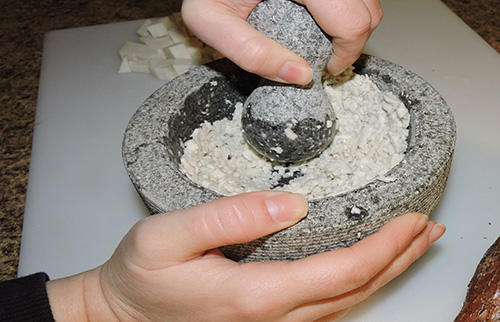
I used a Mexican molcajete, which is a traditional mortar and pestile. Rather than being made out of ceramic, they are usually made out of lava rock, which is very porous. Mine is made out of granite, which isn’t as porous, making it grind less, but is much easier to clean. Traditionally, the Mexicans use these for making salsa and guacamole.The root is hard enough that I found it necessary to beat it with the pestile, breaking it down, before grinding it. You want to get it as fine as you can, ending up with a fibrous mush. Actually, the finer you grind it, the more usable soap you’ll get out of it.
The molcajete isn’t the only way you can grind up the yucca root for use. The same thing can be done with the type of grinding stone that the Indians used for grinding corn. However, I don’t happen to have one of those and it would have been expensive to buy. In the wild, I would look for a flat stone I could use to grind on, with a rounded rock out of a river or stream as my pestile.
Now the Soap
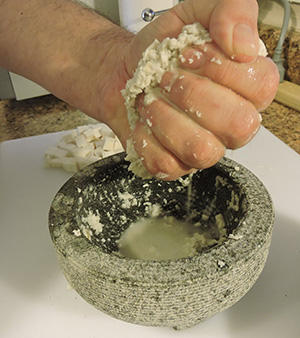
With the root thoroughly ground, you’re ready to extract the soap. All that’s needed it to take the ground root in your hands and squeeze it. The liquid that comes out is usable as soap or shampoo.
If you need to really scrub something, such as a greasy pan, you can use the ground up root as soap. In this case, the fiber in the root will act as a scouring pad, helping you to clean the surface.
But you’ll need to use a fair amount of pressure with it, so as to press the soap out of the fiber as you go.
Even after we’ve gotten a lot of liquid out of the ground root, it is still useful for cleaning. We can dry the root in the sun and save it.
Then, when we need more soap, we can reconstitute it with water, which will draw more of the chemicals we need out of the ground up root, giving us more soap.
It is best, when doing this, to not have pressed out all of the liquid from the ground root, as you will get better soap from it the next time around, if there is still some liquid in it when it is dried.
You may also like:
 Baking Soda – 112 Uses (WWII Series)
Baking Soda – 112 Uses (WWII Series)
World’s Smallest Battery Powers House For 2 Days (Video)
11 Survival Tricks Learned from Homeless People
How to Make Your Own Semi-Automatic Off the Grid Washing Machine (No Electricity)

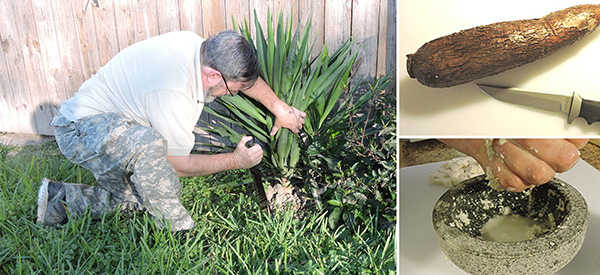













Interesting post. Makes me want to add to my soap and shampoo stores so I can avoid this task as long as possible.
There is one thing in the post that I take issue with, and that’s using a machete to dig up the root. Why risk damaging a good tool? Machetes are made for cutting. Shovels are made for digging.
That’s what I’m doing lately, Hoosier H. Every time I go to Walmart I pick up six packages or so of my favourite soap. I have quite a store of soap on hand. Probably enough for the rest of my life. Yucca really doesn’t do that well where I live. Especially in a winter where we’re regularly having -30’s C and -40’s C. I COULD grow it inside but I don’t want it inside. Also have quite a bit of dishwashing liquid on hand. In a pinch I’m sure you could use dishwashing liquid for your hare. Dishwashing liquid is formulated to be kind to your skin and cut grease so shouldn’t bother your scalp that much and clean your hair at the same time. Speaking of hair, as goofy as it sounds, and to “cut” (ha ha) down on parasites that might get into our hair if we’re forced to be in close proximity such as an underground shelter for an extended period of time, why not just shave our heads? Both men and women alike. Would that not cut down on the probability of us getting scalp-related diseases, ticks, etc. in an extended SHTF situation? And then we wouldn’t need shampoo. Women are also beautiful without hair. Beautiful bald women turn me on. 🙂 Isn’t that the first thing they do with new armed forces recruits. Shave their heads? And isn’t that the main reason why they do that? To cut down on all the scalp and hair related diseases that could occur when people are in close proximity for extended periods of time? You want to come into my shelter, either shave your head or take your chances outside. And for those thinking that a shaved head is too cold in our winters there are always hats, hoods and toques. I’d rather be a little uncomfortable instead of having an infestation of fleas, ticks or whatever in a small, enclosed shelter.
Armin, I have Capt. Picard’s hair line. Just body wash for me. …I don’t know if my wife would cut off her hair or not; probably in a BAD situation, she would. She has had long hair since here teens. That would be a big step. …Hope it never comes to that!
I totally agree. I never use my machete to dig up anything. I keep my machete sharp, and use it only for cutting.
@Armin – Never try to bathe a rabbit – it doesn’t go well.
Making your own soap & shampoo bars is cheaper than buying, especially if you have access to wood ash. Yucca harvesting would have to be a last resort, considering the energy/ calories it would take to harvest & process it, but it’s good to know how, because even if you do stock up (whether making it or buying it), you never know if you might somehow end up separated from your stash.
Grumpus: Yeah, but when you have time on your hands, it makes sense. Yucca peelings are soap, the red of the root is food, and the leaves have long fibers for clothes, rope, and burlap. There are varieties that grow well into Alberta, and I saw them all over parts of Penna and Ohio. Lye stinks. It’s deadly and will eat away skin and flesh. Yucca soap is easy on the skin and heals. It kills fungal infections, lice, fleas, ticks, and wards off flies and mosquitoes. Then take what remains from washing and put it around garbage cans. Rats and mice will eat it and die. Anyone trying to find you can smell lye soap on you hours after washing. niio
Have you ever used a bar of soap? I’m not being snarky – I’m asking an honest question, because it blows my mind, just how many people in this day and age, have never used a bar, only used liquid soaps.
Bar soap is made with lye. And, I promise you, if it ‘stinks’, or burned, you got some from someone who didn’t know what they were doing. Those fancy, expensive, flowery French milled soaps? Made with lye. Irish spring? Lye. Dial? Yup – lye. The Amish made white blocks, with no scent? Lye.
Don’t believe me? Go look at your soap label, for either sodium hydroxide or potassium hydroxide, on the label. In fact, go ahead and look at your bottle of liquid stuff. In fact, go look at your shampoo label. Yup. It’s in there.
Yes, it can be dangerous – if you don’t handle it right, or if you’re stupid enough to take a nice, deep whiff.
But, if you read what I actually wrote, I said that knowing how to use the yucca was a good skill to have.
Yucca is an amazing plant, with many uses. But, it’s not going to help you, if there aren’t any around, or they ground is frozen solid, or in so many other cases. I’m an herbalist. I love plants, and know many uses for plants. But, if you’ve had a fire (thus ashes) & some form of fat, you can make soap. Doesn’t matter if the ground is rock, or ice, or ten feet under snow or water – and a single bar of soap can last far longer than one yucca plant, with far less work to get it done.
If you want soap from plants, there are many with a high enough level of naturally occurring saponins to bathe with, clean your clothes, & your equipment, and yucca is right up there with the best of them. Just don’t get stuck on the idea that yucca is your only option, and don’t get caught with your soap supplies low, because when it is a real emergency/survival situation, you aren’t likely to be able to use your energy, for this process.
Also, many herbs can be infused into the oils and water, in soap making, to give the soap all those other properties, and loads more. I keep a few different soaps in my first aid kit, to address specific things – like a jewelweed & plantain soap, for poison ivy, calendula and lavender, for antibac, antimicrobial, antiviral, bug repelling, and other purposes… I’m not discounting yucca – not at all. I’m planning on adding some to our gardens, next spring, and would have, this year, if it had been possible. In fact, yucca and lye soap play very nicely, together, increasing the benefits of both. 😀
Grumpus: Of course. We always made soap when still farming–Lehighton area, PA, We made soap in an old cast iron kettle in the yard because the fumes are toxic, the wooden boxes and all, right there, knives to cut the bars, and so on. Women in the family would come visit for a weekend to make milk soaps and and scented soaps, but lye stinks and it’s dangerous. Until I was going on ten I wasn’t allowed to help.
I don’t shampoo, and rarely use body wash. Yucca is the best because it heals and cleanes, and is a bug repellent. It’s free, and the white part of the root is good eating. We also have soap tree here, and the leaves can be used. Certain kinds of wild oranges make a good laundry soap. None of them will wear out clothes which lye soap does.
Worse case scenario, use hands. Do you grow soaproot in your yard? We have it all over the brush out back. The seed pods when young can be cleaned and stuffed, then cooked. The whole plant has a use. Flower stalks can get up to 12 feet long, and make good bean poles. Soap can decay, but the plant can last for years in the ground.
Indians used digging sticks to dig up roots. Use your machete to sharpen a stick, then use the stick to dig up the yucca. Plan on encouraging the plant to re-root so it can thrive and you won’t run out of soap.
Yes use the Yucca stalk for the digging stick. Thatd what the Mimbres Indians used in southern New Mexico. I still harvest about 150 sticks per year and use them as walking sticks.
Plenty down here in Yuma. thanks
Seems like a really ton of amount of energy to use for that small amount of soap. Does it keep for a long time? I’m thinking this should be used for emergency only. Is there any way to make more, like adding water or something? Can the left over root (after squeezing) be used for anything? Or eaten?
When we lived in the Canal Zone our buffets at the Officers Club always had Yucca balls in a white sauce along with Iguana and other good stuff.
It is typically yuca (with one “c”) that you find in restaurants. Yucca is a different plant, but both are indeed edible. If eating the stalk or the root of the yucca plant, it needs particular care in its preparation, to remove the saponins (the chemicals useful as soap), but most of the plant is edible.
we just boil before eating or making noodles. Tastes like chestnuts.
If I were fooling around with a yucca plant, I would wear a long sleeved shirt and gloves. In addition to a needle-like thorn at the end of the leaf, the edges of the leaves are as sharp as knives and can cut you quite easily. It doesn’t matter how careful one is, it just takes a split second for the edge of a leaf to drag across your skin to give you a nice cut. In an EOTW situation, cuts are to be avoided like the plague which will also rear its ugly head.
Speaking of plague, big news in SoCal, because of the rats and mice in downtown LA, because of all the bums camping out in downtown, city hall which has refused to do anything significant about the problem except to get a tax passed to build housing for the “homeless,” has been overrun with rodents. As a result, at least one deputy city attorney has come down with typhus from the fleas the rats/mice bring with them. She refuses to return to work until the problem is addressed. It appears that all the carpeting in all the splendid offices will have to be ripped out. Ha! Poetic justice.
They won’t do anything about it. They are too liberally social justice this land is your land this land is my land from California to the New York islands stupid.
That is so sweet!
Hi Claude,
Thank you, for doing what you do. Yucca is very rare, here, so,out here, in California, and up through southern Oregon, we use Soap Root, when were out, camping, sometimes. Here’s a link to a Wiki page, about it.
https://en.wikipedia.org/wiki/Chlorogalum#Uses
Be well
Gee, I don’t know where Wolf lives, but yucca is hardly rare here in SoCal. There is even a town called Yucca Valley for some strange reason. I believe one can dig it on national forrest land and BLM land after obtaining a permission slip from our masters. Could be wrong about that but some plant harvesting is allowed on national forest and BLM land.
If you live in Oregon than you can grow yucca. There are varieties I saw in Pennsaltucky, Georgia, S. Carolina, and so on, not just in the desert. You can get varieties of prickly pear as well that like moisture more than our delightful (cough) local thorns 🙂 I have to get more potato yucca (eating stuff). that’s used for soap, too. Just crush the raw peelings and scrub off. Smells sweet and heals skin problems from acne to zits and anything else.
Hi Claude, Thanks for all the instructions on working with Yucca , just what I was looking ffor. Where I live in the Southwest there are plenty of yucca to use fior soap., especially Spanish Bayonnet. Great for survival mode. I will have to try this out soon!…
I have found the best way to dig these up, even with a shovel, is to tie the leaves up with something. That way you don’t get poked with the sharp needle on the end of the leaf.
Sorry I’m a bit new to this. What in the yucca juice makes it good for soap and shampoo?
Saponins are in the yucca which make it suitable as a soap. I copied this from a website talking about saponins:
“Saponins are chemical compounds that occur in a wide range of herbs, seeds and vegetables. They can also be found in starfish and sea cucumbers. In medicine, they’re used in vaccine formulations to regulate immune function. Due to their antibacterial and foaming properties, these compounds are added to shampoos, soap, household cleaners and makeup products.”
I have read in various places that saponins are mildly toxic to humans, so consuming too much (undefined how much is too much. I guess it is empirical. If you get sick you ate too much.) will cause digestive problems (again, undefined.)
Cooking is supposed to destroy or lessen the toxic content of the saponins. Amaranth and quinoa are reputed to have fairly high saponin content.
I am not a botanist, agriculturist, chemist, nutritionist nor any other scientific food-related “ist”. I just know what I have gleaned from reading on the internet. We all know how incredibly accurate everything we read on the internet is, so be warned about what I have posted above may be totally incorrect.
The Japanese eat sea cucumber. I have never been drunk enough to try it. I am not sure that anything eats starfish, but could be wrong about that.
I live in Ne and I have yucca plants in my yard. Nice to know that I can do something other than admire the plant
like wolf, i have no yucca here, or soap root. as has been mentioned, yucca soap seems like a lot of work for a little product. soap, on the other hand, is pretty easy–not the “soap base” you purchase and add scent and color. i mean fat plus lye. i use rendered lard plus a little coconut oil if i have it and pure granular lye. if i didn’t have lye, i would save hardwood ash in a bucket and when full, make a hole in the bucket near the bottom and then pour water into the bucket. the lye water exits the hole and goes into another container. to tell if the lye is strong enough, put an egg in the lye water. if it floats, it is strong enough. if it sinks, pour the lye water back thru the bucket of ashes. repeat.
Good information. But, what state do you live in without yucca? I was stuck in Penna for years (Zone 4 and 5) and people planted it in their flower gardens.Countryside Small Stock mag has a free download on making all kinds of soap, like milk soap, herbals and so on. Soap Making guide. In the event of SHFT, herbals would be good, like pine tar and so on. Pine tar soap will chase bugs, as well.
Being you are killing the plant, why not just cut of the top and get it of the way
Because you can replant yucca and it’ll root. Soap yucca can grow yards tall. the wind knocks it over and it forms a new plant at the base, and the top roots down.
Does it smell bad? Just curious
I never made a batch of lye soap that we could cook up in the house. It was always done outside because the smell of fresh lye can make you sick. So, no more lye soap, but buy the stuff and will use yucca when we lose the stores.
I already have lost ways I want the lost ways 2 this time thank you Marsha
I don’t know much about different plants and I don’t have much time to study, although I have taken down a few notes from the article and the comments (even though I won’t be able to read every bit of my scribbles), so it worries me. My plan is to make vinegar and wine, LOL, from whatever fruit or even vegetable that it can be made from. The vinegar will be for cleaning and the non-staining wine also, both mixed with a bit of water. The wine that stains will be to drink so I don’t worry so much about looking or smelling bad while removing ticks, headlice or other unwanted guests. I have aloe, lard and or cooking oil if I run out of conditioner and lotion. I’ll end up smelling like fried chicken (more likely spam) if I’m lucky. Hoping the drinking wine makes my (attempted) homemade bread easier to eat. I’ll have to stick with biscuits if it doesn’t. Take care Y’all.